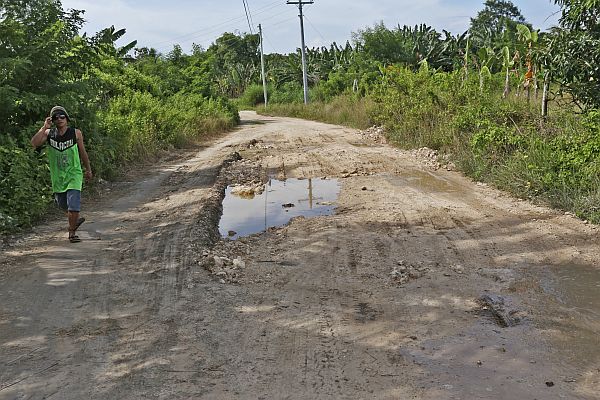Culture of preparedness sets in Cebu

A LOT OF WORK TO DO. The muddy road leading to an unfinished social housing project for Yolanda victims in Barangay Maya, Daanbantayan town.
(CDN PHOTO/JUNJIE MENDOZA)
Four years ago, news of a coming typhoon wasn’t enough to cause concern among households living within its path especially those living in danger zones like riverbanks and landslide-prone areas.
As it turned out, Yolanda (international name Haiyan) was anything but an average typhoon.
The resulting devastation and trail of death it left in its wake spurred the provincial government to require towns to become better prepared.
Baltazar Tribunalo Jr., head of the Cebu Provincial Disaster Risk Reduction and Management Office (PDRRMO), said “a culture of preparedness” made its way to communities.
He credits this to their efforts to strengthen local disaster offices in the province’s towns and cities a few months after Yolanda occurred.
Adaptation
“Four years after Yolanda, we have seen that our disaster risk reduction and management (DRRM) programs have been integrated in each of the municipalities and cities in the province,” he said.
Tribunalo said towns like Tuburan, San Remigio, Tabuelan and even the islands of Bantayan and Camotes already have better disaster management plans and even made it a priority in their programs.
Disaster adaptation is also being practiced in the most vulnerable areas, he said.
For example, those located with 40-meter or 20-meter buffer zones have started transferring to other safer areas to live.
If not, Tribunalo said residents started disaster-proofing their homes to avoid or at least mitigate the effects of disasters on their properties.
Innovations
“We have also developed early warning systems. When it rains or if there’s a typhoon for example, an entire islet will be informed and will evacuate to another island just to make sure,” Tribunalo said.
Other innovations like text blasts and even social media posts are also helpful in disaster management and response, he said.
Tribunalo said his office is working on improving communication lines.
Tribunalo said they now have a P25-million budget for their information technology and communication program to be used to widen existing modes of communication like radio systems in each local government.
Part of the budget will also be used to build base towers to ensure that there are still modes of communication available during disasters.
Updates
“Four years after Yolanda, there is still so much for us to do. Our education, information campaign in schools, barangays, the teachers, local leaders, will continue. We should always be vigilant and prepared,” Tribunalo said.
In Cebu City, community disaster resiliency is a priority with the Cebu City Disaster Risk Reduction and Management Office (CCDRRMO) pointing to the “culture” and “lifestyle” of preparedness in Japan that should be emulated by city residents.
“This means teaching the family what to do in case of not only typhoons but also for floods, fire and even medical emergencies. Preparedness must start in the family,” said CCDRRMO chief Nagiel Bañacia.
Bañacia said their office is conducting workshops and training in barangays to enable residents to responding effectively to disasters and emergencies.
The Catholic Church and other faith-based sectors are being tapped to inform residents on disaster risk management best practices.
Like the province, Bañacia also noted the improved early warning systems in place now compared to four years ago.
“Now, you will receive regular weather updates. Before, that was not there. That’s the difference. That is very important. People would already know and understand the effect of a coming disaster,” Bañacia told reporters.
Disclaimer: The comments uploaded on this site do not necessarily represent or reflect the views of management and owner of Cebudailynews. We reserve the right to exclude comments that we deem to be inconsistent with our editorial standards.
